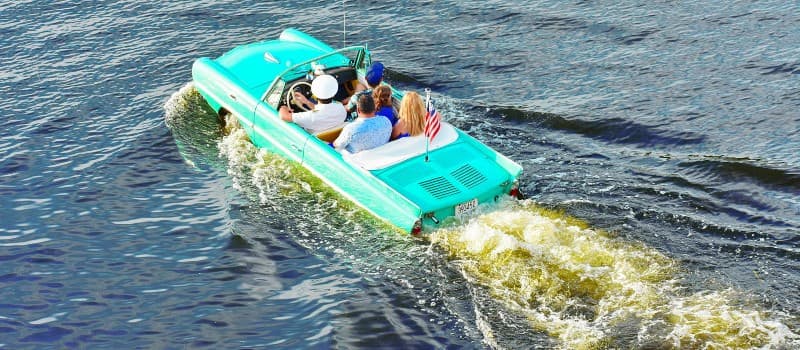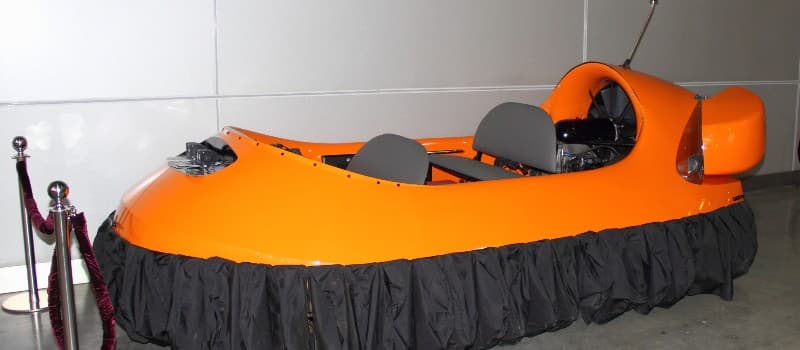
6 crazy car innovations that didn’t stand the test of time
16th Aug, 2022
Modern consumer cars are such a common everyday sight that it’s easy to forget they’ve not actually been around all that long, relatively speaking. Phrases like scrap my car have only been in our lexicon for a few decades – for the vast majority of human history, we’ve used horses and other livestock to get around, and we’ve become pretty good at managing them too.
As the design of the modern automobile gradually evolved over the past century or so, pioneering engineers have had to contend with all sorts of unprecedented kinks and issues, ranging from the trivial to the deadly. Some of the solutions to these issues have been downright ingenious. Others have been… well, rather less so. Today’s blog is about the inventions in that latter category.
1. The fifth wheel parking aid

Nobody loves parallel parking. It’s fiddly, time-consuming, and particularly stressful if you’ve got a long line of cars building up behind you, glaring at you in stony-faced silence as you desperately try and slot yourself into that space for what feels like the hundredth time.
The folks at Cadillac feel your pain, and actually came up with a solution all the way back in the 1950s. That solution involved a fifth wheel that could be lowered from the boot when you got parallel with the space in question. That way you could just… swing your rear end in (so to speak).
You might have already spotted the issue with this though – it doesn’t move the front end of your car any further to its intended destination, so you’ll probably have to do some fiddly parking regardless. Plus, the addition of the fifth wheel immediately took up most of the boot space. In an era when we were just discovering how handy cars could be for moving things about for long distances, it’s easy to see why the public wasn’t too keen.
Probably not surprising, then, that fifth wheel was ultimately deemed ‘impractical’ by Cadillac and abandoned shortly afterwards.
2. Amphibious cars

There’s no denying that the concept of an amphibious car is quite an enchanting one, as you may have already appreciated if you’ve ever seen the Spy Who Loved Me. Bond’s Lotus Espirit takes to the water like a dream, gracefully transforming itself into an underwater craft as Bond quietly relishes the shock of his companion, the normally unflappable Anya Amasova.
That film was released in 1979, at a time when amphibious cars had firmly captured the public’s imagination. The idea was most popular throughout the 60s, 70s and 80s – during that time, some of the world’s biggest automotive brands put their best minds on trying to come up with a car that was safe, practical, and still stylish enough to appeal to the general public. It wasn’t an easy task, even with the resources of massive companies like Porsche and Land Rover, who were just two of the best-known names racing to make a splash in what was seen at the time as a promising new market.
While some designs did make it to production, ultimately they never sold in the staggering numbers that manufacturers were hoping they would, and the most ambitious plans for them were quickly shelved. One notable example that did make it to the mass market was the Amphicar 770. Designed in Germany, it was released in Europe in 1959, and available to American buyers from 1961 onwards. It was was so named for its ability to travel at 70mph on land, and 7 knots in water.

It garnered a mixed response from the American public (one critic’s verdict was: “this vehicle promises to revolutionise drowning”). But one particularly high-profile enthusiast was none other than the US president at the time, Lyndon B Johnson, who enjoyed taking visitors for a spin around his Texas ranch.
The thing is, he often neglected to mention the car’s capabilities before these little excursions. Reportedly, his favourite bit was screaming that the brakes had failed as he plunged them at terminal velocity towards the lake. Once the car was safely afloat, he would then laugh himself silly at their terrified reactions. To be clear, some of his victims were pretty important people – he tried it with everyone from his own staff to visiting foreign dignitaries. Lots of people love a good prank, but very few are able to elevate it to the level of ‘potential international incident’.
Eventually – somewhat inevitably – a terrified passenger leapt out and sprained both her wrist and her ankle, also sustaining a concussion for good measure. As you can imagine, she was pretty unimpressed by the whole affair, and according to a Secret Service Agent who was present, there was noticeable steel in her tone as she told the president that she couldn’t swim. He started giving people a heads-up after that.
The Amphicar was no longer sold after 1967, but there some remain in active service as novelty rides in Disney Springs, Florida. (In case you’re wondering, they’re driven a bit more responsibly there.)
3. Hover cars

It’s easy to see why the idea of hover cars charmed an entire generation. The idea of gliding over potholes, over rough terrain, even over water, and with none of that pesky tyre friction slowing you down. In short, they’re fast and they’re cool. What’s not to love?
Well, as it turns out, quite a lot unfortunately. We’ve already covered some of the real-world considerations with flying cars, and most of them essentially apply to hover cars too. The closest anyone got to a commercially viable hovercar was the Curtiss-Wright Model 2500 Air Car, and it pretty neatly encapsulates some of the issues.
Originally developed as a military prototype, it was retooled for civilian use in the 1960s after being deemed unsatisfactory for field use. It utilised 180hp aircraft engines to elevate itself 15 inches off the ground, which meant it was great over flat terrain, where it could achieve a comfortable 38mph top speed. Whenever things became even slightly bumpy, it frequently got into difficulty – which is a polite way of saying it crashed a lot. (You can already see why that might limit its military applications.)
Plus, there’s the fact that military pilots will put up with things that paying consumers probably won’t. There’s a reason not many modern vehicles use aircraft engines – the things are deafeningly loud, and the extra fuel consumption would make their costs sky-high. With all that considered, it’s no wonder that hover cars didn’t really… take off.
4. The Ford Nucleon

“I know,” said one enterprising engineer to another, some time in the mid-1950s, “why don’t we put a nuclear fusion engine inside a modern consumer car?”
“That sounds like a brilliant idea,” said the second enterprising engineer. “Cars are always driven completely safely and responsibly with zero margin for error so there is no way this will result in an apocalyptic explosion in a sleepy US suburb at the height of Cold War tensions.”
So, they got to work. The result was the Ford Nucleon. To understand a little more about the mindset that went into the creation of this objectively bad idea, it’s worth remembering that the idea of nuclear power was still considered a pretty revolutionary idea at the time. And while the entire world knew all about its destructive capability by then, there were plenty of well-intentioned people busying themselves thinking about how this incredible power could be harnessed for more constructive ideas.
Thankfully, even back then it was fairly obvious to everyone why driving around in a portable nuclear reactor probably wouldn’t be particularly smart. It doesn’t matter careful you are behind the wheel – research suggests that almost every driver will be involved in roughly three to four driving accidents over the course of their lifetime.
In this context, the term ‘accident’ is defined pretty broadly – it can encompass everything from a minor fender bender to a major collision. In cars like these though, even a minor collision might be all it takes. Now, we know that fender benders can be annoying at the best of times, but at least in modern cars they don’t end with both drivers getting atomised – along with anyone else who happens to be in the vicinity.

With all that in mind, it’s probably no wonder that the Ford Nucleon ended up getting consigned to the annals of history. The idea got as far as a scale model though, which you can see on display at the Henry Ford Museum in Michigan.
5. The dog sack
The dog sack (careful how you Google that) was not only considered a serious solution for pet-owning drivers, but the design actually went through several iterations. It started in 1932 with the Bird Dog Palace, which is a very grandiose name for what was basically a steel crate that could be clamped onto the side of the car without damaging it. (Damage to the car, that is. No guarantees about the dog.)
The contemporary adverts for the Bird Dog Palace all aspired to be just as ambitiously upmarket as the name. The descriptions often sold it as a ‘private compartment which fits neatly on the running board’, which is technically true, and went on to declare that ‘dogs are carried comfortably on motor trips’, which is technically not.
Even the taglines normally read something like ‘Travelling Comfort for the Dog’, a proclamation that only applied to dogs who love being deafened by engine noise while hurtling along at dizzying speeds in a rattling cage that was more or less fully exposed to the elements (regardless of the oil-cloth cover that was supposed to protect them from dust and rain).

Fortunately, someone eventually rethought the Bird Dog Palace. Unfortunately, that thought appeared to be something like “this is way too safe / expensive”, because apparently the natural evolution of this idea was the dog sack. It was somehow even more dangerous than the Bird Dog Palace, and was exactly what it sounds like – even the advert labels it simply as a large canvas sack.
In case you can’t see it, that advert in that link opts for a similarly optimistic headline (Dog Rides Comfortably in Sack on Running Board), and the copy just underneath takes care to re-emphasise that “your dog will ride safely in this sack, which is quickly attached or removed.” Hmm. One clause of that statement would appear to invalidate the other, as far as we’re concerned, but then again we’re not automotive designers.
As you might have surmised, there’s no fancy technology involved. It’s a large sack that hooks onto the car, and that’s it. The advert shows a dog’s head calmly poking out from the depths of the bag as if he’s completely chill with the whole deal, because everyone knows that’s definitely how dogs behave in that situation, and they never try to do anything stupid like, say, panic and try to get out. Here’s hoping Rover is fine with going at 50mph, and that nobody tries to overtake you. Ever.
6. A horse head for every car

We know it’s already sounding a little Godfather-esque, but bear with us. It’s a little less sinister than it sounds. But only slightly.
When the first motorcars first began appearing in towns and cities around the world, the vast majority of people understandably found them unsettling. It’s not hard to see why – these early vehicles were two-tonne monstrosities that rattled and roared and creaked and spewed black smoke everywhere. They also had a rather unfortunate tendency to backfire a lot, and since the closest comparable sound at the time was a gunshot, you can see why they freaked people out.
Of course, all this noise and commotion would also regularly spook horses, and since these were the dominant mode of transport back then, this was a really big problem. Happily, someone had the genius idea of sticking a wooden horse’s head on the front of each vehicle. That’ll solve the problem, right?

Hmm, not really. The entire enterprise was a whole catalogue of bad ideas. An actual patent exists. It was filed by one Uriah Smith of Battle Creek, Michigan, in 1889. As far as anyone can tell, this Adventist preacher was the main creative mind behind the concept of Horsey Horseless (yes, that was the actual name for the thing – our guy did not work in branding).
In the words of the man himself, Horsey Horseless was intended to be “a new and original design for a vehicle body, and it has for its object to provide a design of this character that shall be both useful and ornamental.”
We beg to differ on all counts, Uriah. Full marks for creativity and noble intentions, and just so many, many marks off for execution. Essentially, the usefulness of his invention hinged on the idea that horses get scared easily by unfamiliar things, which in fairness is not entirely inaccurate. But a fake wooden head is not the perfect solution to that issue, because a fake wooden head is not a perfect disguise.
Not that you could tell that to Uriah: “The live horse would be thinking of another horse,” he reasoned, “and before he could discover his error and see that he had been fooled, the strange carriage would have passed, and it would then be too late to grow frantic and fractious.”
Safe to say that for all his enthusiasm, Uriah may not have had the greatest insight into how horses’ minds work. People who are actual experts in this sort of thing have pointed out that while your average horse might not be a rocket scientist, he’s still smart enough to recognise the visual difference between a wooden horse head and an actual horse. Most animals are, because it’s a pretty essential survival skill.

Besides, he overlooked something pretty crucial: horses use smell to recognise each other anyway. And as one equine specialist at Rutgers University memorably put it, it doesn’t matter how much horse urine you pour on it – “it’s not gonna smell like a horse.”
It probably didn’t help that the horse’s head was also hollow, and filled with extra fuel – a good idea if you didn’t think about it for more than, like, five seconds. Ultimately though, that made Horsey Horseless not only useless at its primary function, but turned it into an actual hazard.
So in summary, it would have been an ugly, useless, possibly foul-smelling and definitely flammable monstrosity that would be the very first bit of your car to hit something if you crashed.
As you’ll have already guessed from the dearth of equine sculptures adorning car bonnets everywhere today, the idea did not catch on. It did not catch on at quite a startling scale. In fact, it nobody knows if it even got past the patent stage, which is probably just as well.
Now, if your own car is capable of flight, undersea diving, or uh, explosions, then you’ll probably need to get it scrapped by a specialist. For everything else though, rest assured that we’ve got all the tools and expertise we need to recycle your car right here at Scrap Car Network. What’s more, you can rely on us to get you the very best price. All you need to do is enter your car reg and postcode into the fields on our site, and when you’re ready, you can find out the value of your car in as little as 10 seconds!
Curious to find out how much your car is worth?